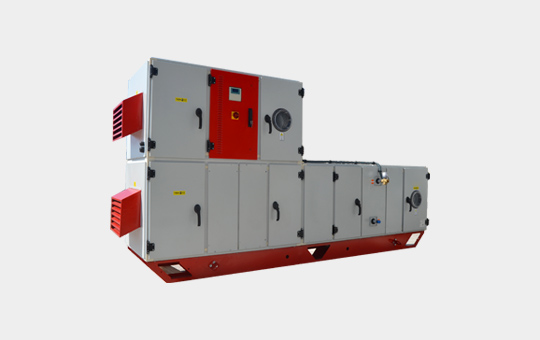Pool dehumidification units are manufactured like conventional air handling unit configurations. The devices are manufactured with a modular structured carcass system. The cell skeleton is manufactured using galvanized steel box profiles. The cell panels are double-walled and 1 mm galvanized sheets with static paint are used on the outside. Inside, stainless steel or epoxy coated galvanized sheets are used. Basalt and diabase containing rock wool is used as insulation material between the two walls. It provides thermal and acoustic insulation thanks to its intense density.
There is a dehumidification circuit consisting of condenser evaporator compressor and expansion valve on dehumidification units. The moist air is passed over the cold evaporator and the water droplets filter through the fins and collect in the drainage chamber. Dry and cold air is raised one or two degrees above the ambient temperature by passing it over the condenser. If more heat is needed, additional heating is performed through the heating coil. Directly driven plug fans are used together with a frequency inverter in the pool dehumidification unit. The automation system of the pool air handling units are manufactured in a completely integrated state on the device. High efficiency scroll compressors are used in the devices.
When temperature and humidity come together, the irritating side of the temperature and the intolerable effects of moisture disturb people more clearly. Especially in closed areas, humidity and heat cause the decrease of oxygen in the air and the increase of harmful gases. In indoor swimming pools, humid-temperature and pool chemicals create different compounds and make it impossible for us to breathe. Pool type dehumidification units serve to reduce the relative humidity in the air to acceptable levels.
In places where other industrial products such as paper and cellulosic materials are stored and where moisture is important, the moisture level is a factor affecting the storage time and determining the processing quality. Package pool stations are used to adjust the moisture balance of the stored materials.
Preserving valuable documents and historical artifacts stored and exhibited in archives and museums for many years depends on the amount of humidity in the air. High humidity is a factor that accelerates decay. It accelerates rusting and decay by oxidizing on moisture materials. Pool air handling units eliminate negative effects by keeping the air drier.
Pool dehumidification air handling units are combined devices that limit the amount of moisture to certain values in indoor swimming pools. In addition to its dehumidification function, it also provides heating of the pool area. Thanks to the hot water coil integrated on the device, it provides the heat energy from the hot water generator to be sent to the environment with the help of fans. When the water molecules suspended in the air touch the surface of the cold evaporator, they quickly reach the dew point and become droplets, moving downward along the serpentine fins and collecting in the drainage chamber. As this process is repeated continuously, the air becomes free of moisture. In addition, the hydrochloric acid in the air is separated. Pool dehumidification units, which operate according to the temperature difference of the indoor and outdoor environment, ensure that the humid air is expelled directly when the outdoor environment is warmer than the indoor environment, and the drier outdoor air is transferred to the indoor environment and the humidity rate is balanced. As the compressors are disabled while doing this, less energy is used. Dampers on the device adjust the amount of fresh air and exhaust according to the difference between indoor and outdoor temperatures.
Air handling units are used in old-style pool ventilation systems. Since there is no dehumidification process in air handling units, the indoor air is completely discharged to the outside and fresh air is supplied from the outside instead. It brings serious energy costs during the transition months and winter months when the outdoor environment is colder. The colder outdoor air must be heated and sent inside. Due to the operating scenario of the dehumidification circuit within the pool dehumidification units, it preserves the existing heat by working completely with the internal air cycle without allowing air to pass from the outside environment in colder times.

